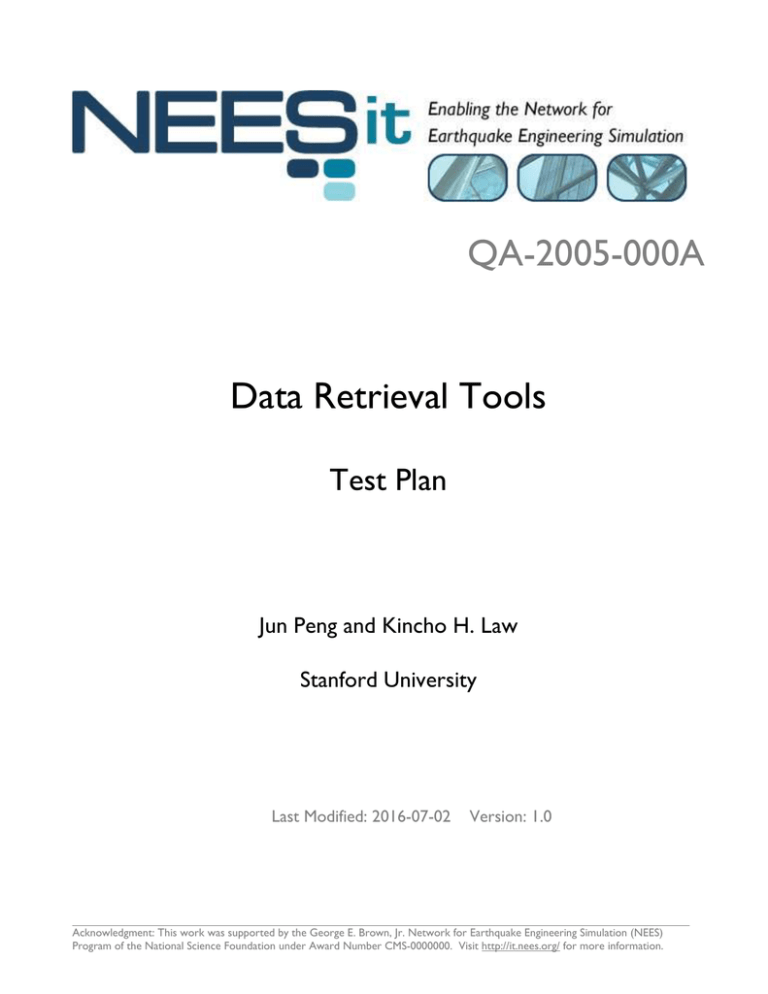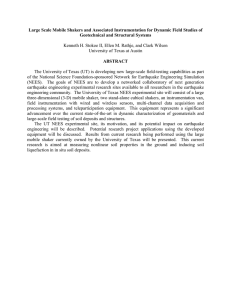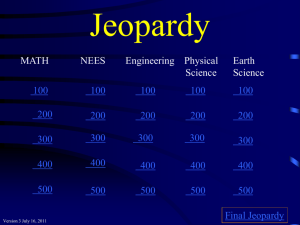Test Plan
advertisement

QA-2005-000A
Data Retrieval Tools
Test Plan
Jun Peng and Kincho H. Law
Stanford University
Last Modified: 2016-07-02
Version: 1.0
Acknowledgment: This work was supported by the George E. Brown, Jr. Network for Earthquake Engineering Simulation (NEES)
Program of the National Science Foundation under Award Number CMS-0000000. Visit http://it.nees.org/ for more information.
[Document Title]
2 of 21
Table of Contents
1
About This Test ............................................................................................................................. 4
1.1
Overview (Test Goals) .......................................................................................................... 4
1.2
Components Covered by This Test Plan .............................................................................. 4
1.3
Test Environment and Conditions ........................................................................................ 4
1.4
Reference, Definitions and Acronyms ................................................................................... 4
2
Approach ....................................................................................................................................... 5
2.1
Types of Testing .................................................................................................................... 5
2.2
Test objectives ....................................................................................................................... 5
2.3
Performance........................................................................................................................... 5
3
Features to Be Tested and Not to Be Tested .............................................................................. 5
3.1
Features to Be Tested ........................................................................................................... 5
3.2
Features Not to Be Tested ................................................................................................... 5
4
Test Execution ............................................................................................................................... 5
4.1
Test Configurations ............................................................................................................... 5
4.2
Test Data ............................................................................................................................... 7
4.3
Test Cases ............................................................................................................................. 8
4.4
Test Reports .......................................................................................................................... 8
QA-2005-[ID]
[Author]
Updated: 2016-07-02
Web it.nees.org
Email it-support@nees.org
[Document Title]
3 of 21
Table of Figures
Figure 1 – The Main Page of the Data Browser ..........................................................................................9
Figure 2 – Detailed Display of the Project MiniMOST ..............................................................................9
Figure 3 – Detailed Display of the Task miniMOST_at_UIUC ................................................................10
Figure 4 – Detailed Display of the InfrastructureSetup .............................................................................10
Figure 5 – Access of Files Showing the InfrastructureSetup ....................................................................11
Figure 6 – Detailed Display of the Task miniMOST_at_UIUC ................................................................11
Figure 7 – Detailed Display of the EventGroup ........................................................................................12
Figure 8 – Detailed Display of the Event miniMOST_test_0228 .............................................................12
Figure 9 – Access of SensorReading for the Event miniMOST_test_0228 ..............................................13
Figure 10 – Main Page to Retrieve MiniMOST Data Saved in MySQL...................................................13
Figure 11 – Display of “Summary” for MiniMOST Experiment ..............................................................14
Figure 12 – Display of “Instrumentation” for MiniMOST Experiment ....................................................14
Figure 13 – Main Page to Retrieve Composite Frame Test Data Saved in OWL .....................................15
Figure 14 – Display of “Specimen” for the Composite Frame Test ..........................................................15
Figure 15 – Access of Drawings for the “Specimen” ................................................................................16
Figure 16 – Display of “Loading System” for the Composite Frame Test ...............................................16
Figure 17 – Access of Drawings for the “Loading System” .....................................................................17
Figure 18 – Main Page of the Report Generator........................................................................................18
Figure 19 – Main Interface of Report Generator for MiniMOST Experiment ..........................................18
Figure 20 – Access of “Specimen” for MiniMOST Data Saved in OWL .................................................19
Figure 21 – Access of “Specimen” for MiniMOST Data Saved in MySQL .............................................19
Figure 22 – Main Interface of Report Generator for the Composite Frame Test ......................................20
Figure 23 – Access of “Infrastructure” Data for the Composite Frame Test ............................................20
Figure 24 – Access of “Loading” Data for the Composite Frame Test .....................................................21
Figure 25 – Access of “Instrumentation” Data for the Composite Frame Test .........................................21
QA-2005-[ID]
[Author]
Updated: 2016-07-02
Web it.nees.org
Email it-support@nees.org
[Document Title]
4 of 21
1 About This Test
1.1 Overview (Test Goals)
The goal of this test is for testing the functionality and usability of the developed data retrieval tools.
The tools are designed to retrieve project data according to a reference data model developed for
shake table and large-scale structural tests (see report NEESgrid-2004-40: Reference NEESgrid Data
Model). The web interfaces to the data retrieval tools will be the main testing environment where the
functionality of the data retrieval tools can be observed. The test results (observed behavior of
software tools) can be compared with the expected behavior, which is specified in the report Data
Retrieval Tools Software Design Specification. The data retrieval tools can pass this test only when the
observed behavior matches the expected behavior.
1.2 Components Covered by This Test Plan
This test focuses on testing the functionalities of the following software components that are
developed to browse and retrieve data related to a project:
Project browser – developed to browse the data and metadata that are related to a
particular project.
Data retrieval tool – developed to facilitate retrieving related data from the data repository
and to present the data to the users according to a pre-defined file hierarchy.
Report generator – implemented to help organizing project data according to a file hierarchy
specified in a report structure.
1.3 Test Environment and Conditions
The following external tools and libraries are employed for the execution of these data retrieval tools:
Jena API to read, write and manipulate OWL files.
MySQL database to store data in relational form.
MySQL Connector J/3.0 (JDBC implementation) to connect Java programs with the MySQL
database.
Java Servlet for retrieving data from the data repository and dynamically generating web pages.
1.4 Reference, Definitions and Acronyms
OWL – Web Ontology Language. OWL is employed to explicitly represent the meaning of
terms and the relationships between those terms defined in the reference data model
(NEESgrid-2004-40: Reference NEESgrid Data Model). OWL is represented in XML format.
http://www.w3.org/2001/sw/WebOnt/.
Jena – A Semantic Web Framework for Java. Jena provides a programmatic environment for
OWL. By using Jena, OWL documents can be parsed and interpreted.
http://jena.sourceforge.net/.
QA-2005-[ID]
[Author]
Updated: 2016-07-02
Web it.nees.org
Email it-support@nees.org
[Document Title]
5 of 21
JDBC – Java Database Connectivity. JDBC is part of the Java Development Kit (JDK) that
defines an API (application program interface) to support standard SQL access to databases
from Java programs. http://java.sun.com/products/jdbc/.
2 Approach
2.1 Types of Testing
The usability and functionality of the developed data retrieval tools can be tested without prior
knowledge of the internal implementation. After a data server is setup and configured, the data
retrieval tools can be accessed via a web interface. Manual testing can be carried out directly using the
web interface to browse and retrieve the project data.
2.2 Test objectives
The data retrieval tools need to be tested to verify (1) if the functionalities of the data retrieval tools
match the specification; (2) if there is any obvious glitch or broken link; (3) how the data retrieval tools
are to be used.
2.3 Performance
System performance will not be tested for current version of the implementation.
3 Features to Be Tested and Not to Be Tested
3.1 Features to Be Tested
The features to be tested include the project browser, a set of data retrieval tools, and the report
generator.
3.2 Features Not to Be Tested
As of this writing, the design of the data repository for NEES has yet to be finalized. Therefore, the
developed reference data model has not been integrated with the data repository and the data
retrieval tools cannot access data from the repository. Instead, a file system and/or a MySQL database
system are used to serve as data storage mechanism for the developed data retrieval tools. The
integration with NEES data repository will not be tested.
4 Test Execution
4.1 Test Configurations
This section describes the setup and the configurations of the external tools and libraries that are
listed in Section 1.3. Please be noted that the following installation instructions are for Windows 2000
or Windows XP systems only. The steps to create or change Windows Environment Variables
are:
1. Right-click on ‘My Computer’ at the desktop.
2. Click on ‘Properties’ and then choose ‘Advanced’ from the top menu bar.
3. Click on the button 'Environment Variables...'.
QA-2005-[ID]
[Author]
Updated: 2016-07-02
Web it.nees.org
Email it-support@nees.org
[Document Title]
6 of 21
4. There are two windows: one is for ‘System Variables’ and the other is for “User variables’.
Normally we want to change ‘System Variables’.
5. If we want to create a new environment variable, for example “%CLASSPATH% = C:\java”, we
can click on the button ‘New...’. On the pop-up window, enter “CLASSPATH” to the text bar
named ‘Variable Name’ and “C:\java” to the text bar named ‘Variable Value’.
6. If we want to change an existing environment variable, for example adding “D:\Tomcat” to the
variable “%PATH%”, we can double-clicking the variable “PATH” from the ‘System Variables’
window. Then on the pop-up window, add “D:\Tomat” to the text bar named ‘Variable Value’.
The following lists the steps to install and configure JDK and Java Servlet:
1. Installation and configuration for JDK (Java Development Kit)
1.1. Download a free JDK package from http://java.sun.com/.
1.2. Install the downloaded JDK package to your preferred location, such as C:\Program Files\Java.
1.3. Change the Windows environment variable %JAVA_HOME% to reflect the location where JDK
package is installed, such as ‘C:\Program Files\Java’.
2. Installation and configuration for Apache Tomcat Java Servlet
2.1. Download a free Java Servlet package from http://jakarta.apache.org/tomcat/
2.2. Install the downloaded package to a location such as
%TOMCAT% = C:\Program Files\Apache Group\Tomcat4.0\
2.3. Change the %CLASSPATH% environment to include:
CLASSPATH = C:\Program Files\Apache Group\Tomcat4.0\common \lib\servlet.jar
2.4. Change the configuration file ‘%TOMCAT%\bin\setclasspath.bat’ by updating the line: ‘set
CLASSPATH=%CLASSPATH%;%JAVA_HOME%\lib\tools.jar’
If OWL files are to be employed as data storage, the following lists the steps to install and configure
Jena:
1. Download a free Jena package from http://jena.sourceforge.net/.
2. Unzip and install the downloaded Jena package to your preferred location, such as C:\Program
Files\Jena.
3. Set a Windows environment variable %JENAROOT% to reflect the location where Jena package
is installed, such as C:\Program Files\Jena.
4. Set the Java classpath (Windows environment variable %CLASSPATH%) to include all the JAR
files in the %JENAROOT%/lib directory
JENAROOT\lib\jena.jar
JENAROOT\lib\xercesImpl.jar
JENAROOT\lib\xml-apis.jar
JENAROOT\lib\icu4j.jar
JENAROOT\lib\concurrent.jar
JENAROOT\lib\jakarta-oro-2.0.5.jar
JENAROOT\lib\antlr.jar
JENAROOT\lib\junit.jar
JENAROOT\lib\commons-logging.jar
JENAROOT\lib\log4j-1.2.7.jar
JENAROOT\lib\rdf-api-2001-01-19.jar
5. Test the Jena installation by running “test.bar” on a Windows Command Prompt.
QA-2005-[ID]
[Author]
Updated: 2016-07-02
Web it.nees.org
Email it-support@nees.org
[Document Title]
7 of 21
If MySQL database is to be employed as data storage, MySQL database can be downloaded, installed
and configured as follows:
1. Installation and configuration for MySQL Database
1.1. Download a free MySQL database system from http://www.mysql.com/,
the preferred version is 4.1.
1.2. Install the downloaded MySQL package to your preferred location, such as ‘C:\Program
Files\mysql’.
1.3. Setup password for the default user 'root'.
Mysql> SET PASSWORD FOR root@localhost=PASSWORD('new_password');
1.4. Delete the default user '' for security reason:
mysql> DELETE FROM user WHERE Host='localhost' AND User='';
1.5. Create a new username/password and grant all priviledges:
mysql> GRANT ALL PRIVILEGES ON *.* TO username@localhost
IDENTIFIED BY 'password' WITH GRANT OPTION;
2. Installation and configuration for MySQL Connector J/3.0 (JDBC)
2.1. Download a free JDBC package from http://www.mysql.com/.
2.2. Unzip the downloaded package to your preferred location, such as ‘D:\jdbc’.
2.3. Set the Java classpath (%CLASSPATH%) to include the JAR file.
For example: CLASSPATH = %CLASSPATH%;D:\jdbc\mysql_jdbc\mysql-connector-java-2.0.14bin.jar
4.2 Test Data
The data from two pre-recorded earthquake experiments are used in this test. These two
experiments are a miniMOST experiment at University of Illinois at Urbana-Champaign and a
composite structural frame test at University of Minnesota:
MiniMOST @ UIUC: The miniMOST experiment equipment was designed to show the capability of
the major service components for the NEESgrid using a small-scale physical experiment setup. An
experiment has been carried out at UIUC by using miniMOST equipment.
Composite Frame Test @ U of Minnesota: The primary portion of this experiment is a cyclic
loading test on one two-story, one-bay specimen, which represents the bottom two stories of a sixstory prototype structure at approximately one-third scale. The steel frame was comprised of W5x19
wide flange columns and W8x13 wide flange beams. The columns and beams were joined through
partially-restrained connections, which are comprised of top and seat angles and double web angles.
The data from these two experiments are ingested according to the developed reference data model
(see report NEESgrid-2004-40: Reference NEESgrid Data Model). For the object-oriented model, data are
ingested using Protégé, which is an open-source software for ontology development (see
http://protégé.stanford.edu). In the two examples, the metadata are saved in two files named
neesmeta_1.2.pprj and neesmeta_1.2.owl.
QA-2005-[ID]
[Author]
Updated: 2016-07-02
Web it.nees.org
Email it-support@nees.org
[Document Title]
8 of 21
For the relational data model, SQL scripts are used to create database schema and to ingest data into
the MySQL database. Examples of SQL script can be found in create.sql, which is used for creating
database schema, and ingestion.sql, which is used for ingesting miniMOST experiment data. Please be
noted that all the aforementioned files are included in the source code release. These files can also be
downloaded from http://eil.stanford.edu/neesgrid/.
4.3 Test Cases
The developed data retrieval tools can access data from both experiments that are saved in either
OWL files or MySQL database. In this test, we will conduct and report the results for the test cases
that are marked in the following table:
miniMOST / OWL
miniMOST / MySQL
Composite / OWL
Project Browser
XX
Data Retrieval Tool
XX
XX
Report Generator
XX
XX
XX
4.4 Test Reports
The following reports the results of the test cases. These tests are conducted via a web browser, and
selected screen shots are presented.
1. Project Browser / miniMOST / OWL
Figure 1 shows the main page of the project browser with a list of saved projects. When we click on a
particular project, say miniMOST-1, the details of the project will be shown on the browser, as
illustrated in Figure 2.
As defined in the reference data model, a Project is a collection (organized group) of Tasks designed to
achieve specific goals and objectives. Following the model, we can navigate and access all the Tasks
that belong to the Project. Figure 3 shows the details of a particular Task named miniMOST_at_UIUC.
One property (or a slot) of a Task object is InfrastructureSetup, which models the assembly and
arrangement of the PrimaryEquipment used for a specific Task. We can access the details of the
InfrastructureSetup object by clicking on the highlighted button as shown in Figure 3.
Figure 4 shows the details of the InfrastructureSetup, which is a collection of text descriptions,
documents (in the format of Word, PDF, Excel, etc.), figures and drawings stored as files. Files are
saved in a web server and their URIs are saved as metadata. The files can be dynamically downloaded
and shown on a web browser, as illustrated in Figure 5.
QA-2005-[ID]
[Author]
Updated: 2016-07-02
Web it.nees.org
Email it-support@nees.org
[Document Title]
9 of 21
Figure 1 – The Main Page of the Data Browser
Figure 2 – Detailed Display of the Project MiniMOST
Each Task in a project may contain one or more EventGroups. The EventGroup object can be
accessed by clicking the highlighted button shown in Figure 6. The details of a particular EventGroup
object named miniMOST_UIUC_EventGroup_2004 are shown in Figure 7.
QA-2005-[ID]
[Author]
Updated: 2016-07-02
Web it.nees.org
Email it-support@nees.org
[Document Title]
10 of 21
Figure 3 – Detailed Display of the Task miniMOST_at_UIUC
Figure 4 – Detailed Display of the InfrastructureSetup
QA-2005-[ID]
[Author]
Updated: 2016-07-02
Web it.nees.org
Email it-support@nees.org
[Document Title]
11 of 21
(a) MiniMostWiring.pdf
(b) Mini_MOST_overall.jpg
Figure 5 – Access of Files Showing the InfrastructureSetup
Figure 6 – Detailed Display of the Task miniMOST_at_UIUC
QA-2005-[ID]
[Author]
Updated: 2016-07-02
Web it.nees.org
Email it-support@nees.org
[Document Title]
12 of 21
Figure 7 – Detailed Display of the EventGroup
An EventGroup is defined as a collection of Events, each of which can be accessed from the
EventGroup object. The details of an Event named miniMOST_test_0228 are shown in Figure 8. An
Event, which is the atomic level of an Activity, refers to a single run of an experiment or a simulation.
Experimental results, such as SensorReading, can be accessed from an Event object, as shown in Figure
9.
Figure 8 – Detailed Display of the Event miniMOST_test_0228
QA-2005-[ID]
[Author]
Updated: 2016-07-02
Web it.nees.org
Email it-support@nees.org
[Document Title]
13 of 21
Figure 9 – Access of SensorReading for the Event miniMOST_test_0228
2. Data Retrieval Tool / miniMOST / MySQL
Figure 10 shows the main page of the data retrieval tool in accessing experiment data that are saved in
MySQL. A user can choose a project and the category of interest. Once the selection is processed, the
retrieved data will be shown on the browser. For example, Figure 11 shows the data related to
category “Summary” and Figure 12 shows the data related to category “Instrumentation”.
Figure 10 – Main Page to Retrieve MiniMOST Data Saved in MySQL
QA-2005-[ID]
[Author]
Updated: 2016-07-02
Web it.nees.org
Email it-support@nees.org
[Document Title]
14 of 21
Figure 11 – Display of “Summary” for MiniMOST Experiment
Figure 12 – Display of “Instrumentation” for MiniMOST Experiment
3. Data Retrieval Tools / Composite Frame Test / OWL
QA-2005-[ID]
[Author]
Updated: 2016-07-02
Web it.nees.org
Email it-support@nees.org
[Document Title]
15 of 21
Data retrieval tools can also be used to retrieve and organize data saved in OWL files. As shown in
Figure 13, a main page is provided to retrieve the experiment data from the composite frame test.
Based on the category of interest, certain related data are retrieved and shown on the browser.
Figure 14 shows the data related to category “Specimen”. Detailed information about “Specimen” can
be accessed from this page, such as a particular drawing of the specimen shown in Figure 15. Similarly,
description and detailed information about “Loading System” can be retrieved, as shown in Figure 16
and Figure 17.
Figure 13 – Main Page to Retrieve Composite Frame Test Data Saved in OWL
Figure 14 – Display of “Specimen” for the Composite Frame Test
QA-2005-[ID]
[Author]
Updated: 2016-07-02
Web it.nees.org
Email it-support@nees.org
[Document Title]
16 of 21
Figure 15 – Access of Drawings for the “Specimen”
Figure 16 – Display of “Loading System” for the Composite Frame Test
QA-2005-[ID]
[Author]
Updated: 2016-07-02
Web it.nees.org
Email it-support@nees.org
[Document Title]
17 of 21
Figure 17 – Access of Drawings for the “Loading System”
4. Report Generator
The main page for the Report Generator is shown in Figure 18. The same interface is used for
accessing the data saved in either OWL files repository or MySQL database. Once a particular project
is chosen, the main interface of the report generator will be shown. As illustrated in Figure 19, the left
frame of the main interface displays buttons which represent the categories as defined in the report file
hierarchy. Upon clicking on a particular button, the right frame displays the content of that category.
For example, Figure 19 shows the miniMOST experiment data related to category “Summary”.
Besides retrieving the project data from the data repository, the Report Generator also supports the
scenario where project data are saved in different types of repositories. For instance, miniMOST
experiment data are saved in OWL files as well as in a MySQL database. Figure 20 shows the interface
to access miniMOST experiment data saved in OWL files, whereas Figure 21 shows the interface to
access miniMOST experiment data saved in MySQL database.
Another test case is using the Report Generator to access the composite structural frame test data
saved in OWL files. The main interface to access the test data is shown in Figure 22. The content of a
particular category can be directly accessed. Figure 23 shows the data related to category
“Infrastructure”, Figure 24 shows the data related to category “Loading”, and Figure 25 shows the data
related to category “Instrumentation”.
QA-2005-[ID]
[Author]
Updated: 2016-07-02
Web it.nees.org
Email it-support@nees.org
[Document Title]
18 of 21
Figure 18 – Main Page of the Report Generator
Figure 19 – Main Interface of Report Generator for MiniMOST Experiment
QA-2005-[ID]
[Author]
Updated: 2016-07-02
Web it.nees.org
Email it-support@nees.org
[Document Title]
19 of 21
Figure 20 – Access of “Specimen” for MiniMOST Data Saved in OWL
Figure 21 – Access of “Specimen” for MiniMOST Data Saved in MySQL
QA-2005-[ID]
[Author]
Updated: 2016-07-02
Web it.nees.org
Email it-support@nees.org
[Document Title]
20 of 21
Figure 22 – Main Interface of Report Generator for the Composite Frame Test
Figure 23 – Access of “Infrastructure” Data for the Composite Frame Test
QA-2005-[ID]
[Author]
Updated: 2016-07-02
Web it.nees.org
Email it-support@nees.org
[Document Title]
21 of 21
Figure 24 – Access of “Loading” Data for the Composite Frame Test
Figure 25 – Access of “Instrumentation” Data for the Composite Frame Test
QA-2005-[ID]
[Author]
Updated: 2016-07-02
Web it.nees.org
Email it-support@nees.org





